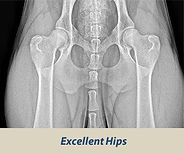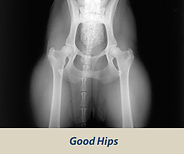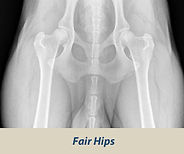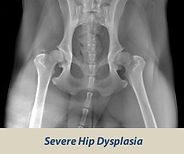Health Testing for Corgis
Part of being a responsible breeder is making sure that you are educated in what issues the breed can develop. We spent many years researching the breed before we made the leap and purchased our first Corgis for breeding. We have purchased Corgis before who have not passed these tests, and decided to not breed them. As with anything in life, there are tough decisions that breeders must make, as not every test is "black and white" - "passing or not". On this page, I hope to give as much information as I can on each test that we have done to clear our Corgis of generic issues that the breed is known for, and what they mean.



Degenerative Myelopathy (DM)
"Degenerative Myelopathy (DM) is a progressive, degenerative disorder of the spinal cord that causes muscle wasting and gait abnormalities." This is a later-in-life issue that slowly causes the Corgi to become paralyzed and then incontinent while their brain is still at 100%. This is a controversial test for many breeders, as it is a relatively new test in the last 20 years. Corgis have been the breed that have helped create the test, though it is common in other breeds such as German Shepherds. There have been some user error issues with the tests in the past, as well as reports of fraudulent testing done in the past that have put some breeders, and the DNA testing, under scrutiny.
To test the legitimacy of this testing, we took two dogs - a Clear (N/N) and an At Risk (A/A) and tested them using three different companies. We then sent in tests to the same three companies of the same two dogs, only labeled them "Puppy 1" and "Puppy 2". All of the tests came back with the correct results, and we have yet to see a discrepancy in results.
However - if you can clear your dog and match them responsibly with a dog who will help keep their puppies from being at risk of this disorder, it should be done. I have witnessed the progression of DM through a friend's Corgi, and I do not wish to inflict that on any of my puppies or their future families.
Mode of Inheritance: Autosomal dominant (incomplete penetrance) / Recessive
Alleles: N = Normal/Unaffected, A = DM (mutated Gene)
Explanation of Results: (UC Davis's explanation)
-
Dogs with N/N ( CLEAR ) genoytpe will not have degenerative myelopathy and cannot transmit this variant to their offspring.
-
Dogs with N/A ( CARRIER ) genotype will not have degenerative myelopathy, but are carriers. They will transmit this variant to 50% of their offspring. Matings between two carriers are predicted to produce 25% degenerative myelopathy-affected puppies.
-
Dogs with A/A ( AT RISK )may have degenerative myelopathy, a disabling condition, and will transmit this variant to all of their offspring.
So, the question is - why would you breed a Corgi who is a Carrier or At Risk for the disease? As of November 2022, you can see on the OFA database that only 13.5% of the tested Corgis are DM Clear (therefore not carrying the mutated gene). If you were to breed only clear dogs, you are cutting out 86.5% of the gene pool within the breed. By doing so, you could be amplifying other issues within the breed. So, we fancy ourselves as geneticists when we are breeding. Even an At Risk dog, who carries two copies of the mutation, can be bred to a Clear. All of their puppies would be Carriers, but not at risk for developing the disease.
Here at Corgi Bliss, we only breed Carriers with Clears so that none of the puppies could inherit two mutations. If we have any At Risk dogs in our breeding program to help broaden the gene pool, we would also only breed them with a Clear partner.
Von Willebrand Disease (vWD)
Von Willebrand disease (vWD) is an inherited bleeding disorder resulting from a lack or reduced level of a normal blood clotting protein called von Willebrand factor (vWF). Disease presentation varies from asymptomatic to spontaneous hemorrhaging and prolonged bleeding after injury, surgery, or giving birth. Age of onset varies with some dogs only becoming obvious “bleeders” later in life. Without medical intervention, uncontrolled bleeding can result in death.
Mode of Inheritance: Autosomal dominant (incomplete penetrance) / Recessive
Alleles: N = Normal/Unaffected, vWF = Von Willebrand disease (vWD)
Explanation of Results: (UC Davis's explanation)
-
Dogs with N/N genotype will not have Von Willebrand disease Type I and cannot transmit this variant to their offspring.
-
Dogs with N/vWF genotype may be affected and develop Von Willebrand disease Type I. They will transmit this variant to 50% of their offspring.
-
Dogs with vWF/vWF genotype may be affected and develop Von Willebrand disease Type I, a blood clotting disorder, and will transmit this variant to all of their offspring.
Exercise-Induced Collapse (EIC)
Exercise-induced collapse (EIC) is characterized by muscle weakness, lack of coordination, and life-threatening collapse after intense exercise in otherwise apparently healthy dogs. Affected dogs tolerate mild to moderate activity but will display signs of EIC after 5-20 minutes of strenuous exercise. The severity of EIC varies. EIC episodes last from 5-25 minutes with a gradual return to normal with no apparent residual weakness or stiffness.
Mode of Inheritance: Autosomal recessive
Alleles: N = Normal, EIC = Exercise-induced collapse
Explanation of Results:
-
Dogs with N/N genotype will not have exercise-induced collapse and cannot transmit this EIC variant to their offspring.
-
Dogs with N/EIC genotype will not have exercise-induced collapse, but are carriers. They will transmit this EIC variant to 50% of their offspring. Matings between two carriers are predicted to produce 25% exercise-induced collapse-affected puppies.
-
Dogs with EIC/EIC genotype will be prone to exercise-induced collapse, a serious but usually manageable neuromuscular disorder.
Hip Dysplasia
Canine Hip Dysplasia typically develops because of an abnormally developed hip joint, but can also be caused by cartilage damage from a traumatic fracture. With cartilage damage or a hip joint that isn’t formed properly, over time the existing cartilage will lose its thickness and elasticity. This breakdown of the cartilage will eventually result in pain with any joint movement.
There are several organizations that can "grade" hip xrays and determine if the dog is at risk of developing, or currently has Dysplasia. The goal is to breed only 'passing" hip scores so that the puppies produced have less of a chance of inheriting this painful defect.
These organizations include OFA, FCI, SV (German) and PennHip. Currently we use OFA as our main testing organization, as we love their open database. You can search for dogs and their health results on their website here.
The OFA (Orthopedic Foundation for Animals) classifies hips into seven different categories: Excellent, Good, Fair (all within Normal limits), Borderline, and then Mild, Moderate, or Severe (the last three are considered Dysplastic).
-
Excellent: Superior conformation; there is a deep-seated ball (femoral head) that fits tightly into a well-formed socket(acetabulum) with minimal joint space.
-
Good: Slightly less than superior but a well-formed congruent hip joint is visualized. The ball fits well into the socket and good coverage is present.
-
Fair: Minor irregularities; the hip joint is wider than a good hip. The ball slips slightly out of the socket. The socket may also appear slightly shallow.
-
Borderline: Not clear. Usually more incongruency is present than what occurs in a fair but there are no arthritic changes present that definitively diagnose the hip joint being dysplastic.
-
Mild: Significant subluxation present where the ball is partially out of the socket causing an increased joint space. The socket is usually shallow only partially covering the ball.
-
Moderate: The ball is barely seated into a shallow socket. There are secondary arthritic bone changes usually along the femoral neck and head (remodeling), acetabular rim changes (osteophytes or bone spurs) and various degrees of trabecular bone pattern changes
(sclerosis). -
Severe: Marked evidence that hip dysplasia exists. The ball is partly or completely out of a shallow socket. Significant arthritic bone changes along the femoral neck and head and acetabular rim changes.






Elbow Dysplasia
This is a tough one, as it is not required to be part of the CHIC program through OFA, but it is a rising issue within the breed as they are becoming heavier and heavier. The front end of a dog carries more weight than the back end, so there is more stress on the front, and so issues can at times seem more dramatic.
Elbow dysplasia is a general term used to identify an inherited polygenic disease in the elbow. Three specific etiologies make up this disease and they can occur independently or in conjunction with one another. These etiologies include:
-
Pathology involving the medial coronoid of the ulna (FCP)
-
Osteochondritis of the medial humeral condyle in the elbow joint (OCD)
-
Ununited anconeal process (UAP)
Studies have shown the inherited polygenic traits causing these etiologies are independent of one another. Clinical signs involve lameness which may remain subtle for long periods of time. No one can predict at what age lameness will occur in a dog due to a large number of genetic and environmental factors such as degree of severity of changes, rate of weight gain, amount of exercise, etc.. Subtle changes in gait may be characterized by excessive inward deviation of the paw which raises the outside of the paw so that it receives less weight and distributes more mechanical weight on the outside (lateral) aspect of the elbow joint away from the lesions located on the inside of the joint. Range of motion in the elbow is also decreased.
Cardiac / Heart Testing
Every Corgi here at Corgi Bliss has been examined by a Cardiologist, a heart specialist for dogs, and deemed clear of any congenital cardiac diseases. While it is acceptable for a regular vet to sign off on a regular heart check as a Practitioner, we have found that we can only trust a cardiologist when we are purchasing dogs. '
We once purchased a near two year old Corgi female from a breeder and were surprised when not only the Cardiologist heard of murmur, but our regular vet did as well. And this dog would have been bred on her upcoming heat before we bought her! We ask so much of our vets - they have to be a jack of all trades, and master of all as well. So taking our dogs to a specialist who has trained for years to hear the subtle nuances, and understand the differences is very important when you are clearing a dog as fit for breeding.
We do our Cardiac Testing through the OFA's Cardiac clearances. You can read more about it on their page here!
Eye / CAER Testing
Eye issues such as retinal dysplasia and cataracts are also an issue in the breed. So, we have a few amazing Opthamologists that our Corgis visit a few times throughout their breeding career to make sure that everything looks correct.
As mentioned at the beginning of this page, some health tests are not as "black and white" in their results. This is one of them. While we always want our dogs to be completely clear of any genetic issues, sometimes there are smaller conditions in the CAER testing database that are still considered passing. If you are breeding a dog with one of these issues, it is usually acceptable to breed them with a dog who has no issues. Breeding two dogs with the issue is where you usually run into monumentally larger issues with their offspring.
You will often see dogs with these small issues with "Breeder Option Noted" on their OFA Certificates. If this dog is perfect in every other way, it is acceptable to breed them with a dog who does not have that issue.
We do our Eye Testing through the OFA's CAER clearances. You can read more about it on their page here!






